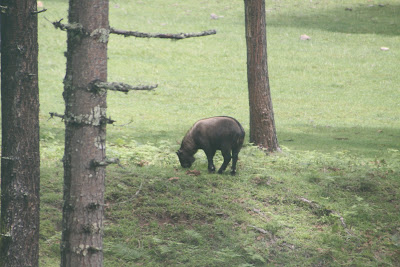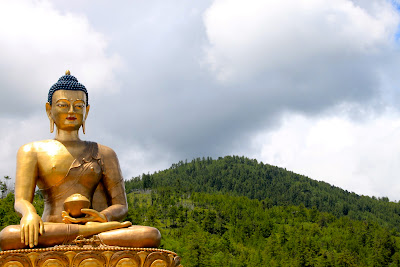Staff orientation has begun, so I have been more occupied as of late. Oh yeah, I'm here to work...
I am glad to have begun with orientation, since it has been covering a lot of my questions about my work and living on campus. Plus it is a good chance to spend time getting to know the faculty and staff of RTC. The returning staff will be – ahem – returning on Wednesday.
Yesterday (Sunday) was a non-meeting day, but we were given a tour of the sites of Thimphu. This was great, as I had not explored anything outside of the main part of the city. Our first stop was the magnificent Trashi Chhoe Dzong. "Dzong" is roughly translated as "fortress-monastery" and every district has one as an administrative center of government. In Thimphu, Trashi Dzong is quite special because it contains the throne room of His Majesty as well as several ministries of national government. The main parliamentary building is separate and across the river (to the left in the picture below). The original Dzong for Thimphu was built in 1216, further expanded by the founder of modern-Bhutan, Ngawang Namgyal in the 1600s, and subsequently destroyed in a fire in the 1700s. However, portions of the current dzong are as old as the 17th century. Trashi Chhoe Dzong was greatly expanded in 1962 by the 3rd Druk Gyalpo ("Dragon King") to house national government as Thimphu became the Bhutanese capital city only in the mid-twentieth century. It should be noted that the entire dzong is constructed using traditional methods – meaning no nails and no architectural plans. Amazing...
I am glad to have begun with orientation, since it has been covering a lot of my questions about my work and living on campus. Plus it is a good chance to spend time getting to know the faculty and staff of RTC. The returning staff will be – ahem – returning on Wednesday.
Yesterday (Sunday) was a non-meeting day, but we were given a tour of the sites of Thimphu. This was great, as I had not explored anything outside of the main part of the city. Our first stop was the magnificent Trashi Chhoe Dzong. "Dzong" is roughly translated as "fortress-monastery" and every district has one as an administrative center of government. In Thimphu, Trashi Dzong is quite special because it contains the throne room of His Majesty as well as several ministries of national government. The main parliamentary building is separate and across the river (to the left in the picture below). The original Dzong for Thimphu was built in 1216, further expanded by the founder of modern-Bhutan, Ngawang Namgyal in the 1600s, and subsequently destroyed in a fire in the 1700s. However, portions of the current dzong are as old as the 17th century. Trashi Chhoe Dzong was greatly expanded in 1962 by the 3rd Druk Gyalpo ("Dragon King") to house national government as Thimphu became the Bhutanese capital city only in the mid-twentieth century. It should be noted that the entire dzong is constructed using traditional methods – meaning no nails and no architectural plans. Amazing...
Trashi Chhoe Dzong.
Me, overlooking Trashi Dzong.
From there, we went up into the mountains and to a locally-favorite vantage point at the Bhutanese Broadcasting Service tower. On the road we encountered many prayer flags and small "chortens" placed into the side walls of the road and along the edge. A Chorten (in Hindi, "Stupa") is a Buddhist monument that houses religious artifacts and relics. Many chortens are said to house relics direct from The Buddha himself. These "mini-chortens" on the side of the road are placed by the Bhutanese as an offering either to commemorate a deceased family member or to solicit good luck on a journey or endeavor. Prayer flags serve the same function, essentially. What is interesting is that you can only place chortens or tie prayer flags on certain days of the week, as they are auspicious. Auspiciousness plays a big role in Bhutanese culture (although this is not unique to Bhutan, as most Asian cultures recognize auspicious signs).
Mini-chortens
As you can see, placing them is quite popular.
Also ubiquitous: prayer flags.
We drove along the mountain passes to the Motithang Takin Preserve to observe Bhutan's national animal: the Takin. Takins were said to have been created by the "Divine Madman of Bhutan," a lama that was known for his outrageous acts. He created the Takin by jumbling the bones of many animals together and reanimating them and, indeed, the Takin is an odd mixture of a goat, yak, and buffalo. In fact, taxonomists still haven't figured it out and had to create an entirely unique category for it.
The Takin.
Chiles drying in the sun near the Takin Preserve.
After Motithang, we further drove along the mountain's edge to reach Buddha Dordenma Viewpoint. While the golden Buddha is still under-construction, the statue itself is quite impressive. Painted with gold and containing a huge diamond in the center of its "third eye," Buddha Dordenma is also a chapel that will eventually house 125,000 smaller Buddha statues! (Yes, I typed that correctly.) It also offers a commanding view of Thimphu and, to the east, of RTC.
That's RTC nestled in the mountains in the middle of the frame.
RTC closer up.
The golden Buddha – Buddha Dordenma.
Thimphu valley.
We drove into town for lunch, and I ate with my new Dutch friends Jeanette and Tijn and their two adorable kids. Jeanette is in the political science department, and we will work closely together with our classes (since I am teaching at least one political science course). Jeanette's husband, Tijn, is going to work for the Royal Textile Museum and their kids will attend a kind of International Bhutanese school. We ate at a decent Bhutanese-Indian-Tibetan-Chinese restaurant called Restaurant Ama. We still don't have a good sense of the portions here, since the food prices are so cheap, and we ordered way too much food. For example, on the menu was listed momos (Tibetan dumplings – very popular here) for Nu35 ($0.65). We figured it was per-piece, given the price, and ordered 6. Nope, that price was for a plate of 6 and we ended up with 36 momos between the three of us! Being only the appetizer, you can guess how the rest of the ordering went down.
At Clock Tower Plaza, in the middle of Thimphu, there was a benefit concert of the very recently destroyed Wangdue Phodrang Dzong (http://edition.cnn.com/2012/06/26/world/asia/bhutan-dzong-fire/index.html). The Wangdue Phodrang Dzong, in western Bhutan, was built in 1638 by Zhabdrung Ngawang Namgyal and is an important site in the autumn tsechu festival. The loss of Wangdue hit Bhutan very hard, and conversations both on the street and in the Kuensel still buzz about it. His Majesty has promised to rebuild the dzong.
Clock Tower Square and the fundraising concert.
Our final stop on the tour was at Thimphu's National Memorial Chorten. Unlike seemingly everything else in Bhutan, this chorten is relatively brand new – having been built in 1974. Despite its newness, this is still a very sacred place for the Bhutanese, and throughout the day you will find people meditating and circumambulating the chorten spinning prayer wheels and holding beads. It seems that mostly the elderly are engaged in this practice. The giant prayer wheels are continually spun by elderly women from morning until night. I made my first Bhutanese faux pas as I entered the building with the prayer wheels with my shoes on and was gently scolded by an elderly Bhutanese women that I should remove them. Oops! Now I know...
National Memorial Chorten.
The giant prayer wheels.
Unfortunately, this time of year is not that great for photography as it is mostly overcast and the light is very diffuse. I am still trying to get the hang of my new DSLR (a Canon T1i) so if anyone has any good digital photography tips for shooting in these kinds of conditions, I would love to receive them. Mostly I have been adding some color back in post-production, but I would rather set the camera right before taking the photo.
The monsoon season lasts about another month, and then September and October become absolutely spectacular –I hear – as there is virtually no rain and no clouds and 65 degrees pretty much all the time. Emily will be coming at the perfect time (Sept. 7). Maybe if you're lucky, she'll even contribute a blog post or two :)
















Question that Dad and I were wondering about - is there the concept of a weekend in Bhutan? You mentioned not having orientation on Sunday. Are classes 6 days a week? Also John Helmers was asking me some questions today and we wondered if the Bhutanese eat much bread. If so, is it more like naan and other Indian breads?
ReplyDeleteGreat pictures Matt! Can you confirm that when He created the Takin and sent it into the wild He said, "Release the Takin!"
ReplyDeleteMom: Bhutan has a 6-day work/school week, but on Saturdays everything is finished by noon (including RTC). My Saturday mornings I will most likely be advising seniors on their senior projects. Sundays are very busy in Thimphu as the entire town is out and about doing errands and such. Even though it is a 6-day work week, it is a very RELAXED work environment – especially for civil servants (the Bhutanese government is the largest employer here). It certainly is not a grueling 9-5 for 6 straight days. Getting paid per hour is a pretty foreign concept here, as everyone is salaried so the work pace can vary. As far as bread is concerned, there are Indian breads available – mostly chapati and roti – but it is not common in the traditional Bhutanese meals (pretty rice-based). There are also several Western-style bakeries that deliver their breads to the shops, and that is where I get it. I discovered the other day that there is a bread bakery that employs persons with disabilities - so I am interested to check that out. Western-style breads are also served in the coffee shops and cafes that have sprung up all over Thimphu.
ReplyDeleteChris: We are talking about the "Divine Madman of Bhutan," so anything is possible.